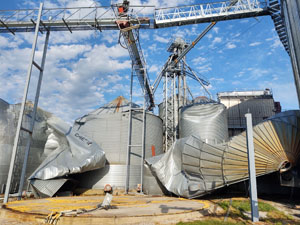Industry analysts, government officials, and insurance adjusters are trying to make sense of just how much damage was done by the heavy winds that cut through the heart of the Corn Belt in a Monday storm system.
At first glance, images of damaged grain bins and fields of corn lying level with the ground gave the impression of total devastation in the wake of the storm — dubbed a derecho as it brought a quick burst of winds topping 100 miles per hour through parts of Iowa and surrounding states. But a deeper look reveals that the impact could have been much worse.
“There’s never a good time to have a derecho, but if this had happened a month ago, it basically would have been a total loss across the path” Arlan Suderman, chief commodities economist for StoneX," told Agri-Pulse. “The corn stalks would have been brittle and would have snapped. There was some of that, but most of what we’ve seen so far is the corn simply bent over and it will try to curl back up and continue to grow.”
Suderman said while analysts are working to determine the scope of the damage, they’re estimating 10-12 million acres were “impacted by strong storms” with 6.5 million of those acres “most significantly impacted by the damaging winds.” Those figures line up with an estimate relayed by Iowa Gov. Kim Reynolds in remarks to reporters Tuesday.
“When I say 10 million acres, that is a really early estimate,” she said. Some 30.6 million acres are farmed in the state, according to USDA’s National Agricultural Statistics Service. “I’ve started to hear from farmers across the state who have just indicated they have never seen anything like this.”
She hopes she can do a flyover soon to get a better idea of the damage around the state.
At this point, officials and producers alike are trying to determine if crops were damaged or will amount to a total loss. Lance Lillibridge grows corn and soybeans northwest of Cedar Rapids and said one of his soybean fields is currently littered with debris from neighboring farms.
“There’s many fields here, I mean hundreds of thousands of acres that are completely destroyed and there will be no return. I mean there’s nothing there, it’s gone,” Lillibridge said. “I haven’t seen a standing machine shed yet in this area.”

Iowa Ag Secretary Mike Naig
Speaking to reporters Tuesday, Iowa Ag Secretary Mike Naig said the next few days will be needed to judge the extent of the damage.
“This next week will tell us a lot about the fate of the crop,” he said. “There’s a lot of corn that’s laying down, and some of that corn will still make a crop … and other parts of the crop will be damaged and not be able to be harvested. Really, only time will tell.”
Some of that damage will also take a while to be officially reported due to loss of power and connectivity for many of those hit by the storm. Jack Tank, owner of Ag Risk Insurance in Iowa City, said many of his customers are struggling to inform him of damage to their crops and facilities because the storm also took many cell towers out of commission. That, coupled with downed trees blocking roads all over the state, is only exacerbating what looks to be a lengthy recovery process.
“It’s a monumental task; everybody’s got to get internet first and cell numbers that work and then there’s lot of people just trying to get feed to pigs,” he said. “This is a massive storm that will be felt for months if not a couple years.”
In addition to crop damage, Tank said he’s also heard of many hog confinement facilities suffering storm damage, but no losses of hogs at this point.

Grain bins damaged in the storm (Photo: Ron Heck)
Tank said many of the losses for producers — specifically loss of crop yield and loss of grain bins and other on-farm facilities — will be covered, but maybe not to the extent producers might hope.
“These grain bins, they’ve gone up in cost, and there’s going to be some surprises what it’s going to cost to replace some of these bins,” he said.
To make matters worse, what’s lost might take a while to replace.
“Contracts to build storage was already taxed to the max, so getting new storage built this year for new people is going to be nearly impossible,” Don Roose with U.S. Commodities told Agri-Pulse.
Naig said he didn’t have exact figures on storage losses, but said tens of millions of bushels of commercial gran storage were damaged, as were millions of bushels in on-farm storage. That’s on top of an already tight storage environment due to recent low prices, leaving many wondering where the upcoming harvest will go.

Arlan Suderman, StoneX
Sources reached by Agri-Pulse all underscored the difficulty the next few months will bring, but also said they didn’t anticipate the need for ad hoc disaster assistance, noting many of the losses would be covered by existing insurance programs. Sen. Chuck Grassley, R-Iowa, said the federal government steps in after crop insurance has made payments and assessments.
Interested in more coverage and insights? Receive a free month of Agri-Pulse.
“The federal government doesn’t come in until after private insurance has been taken care of and if there’s anything short of that,” Grassley told reporters Tuesday.
The situation could also have a negative impact on basis as producers try to market their grain later this fall.
“If you’re a farmer and you lost your bins, you have to find someplace else to go with your corn,” Suderman said, noting that he’s still “trying to ascertain what the scope of that would be, but in some locations I anticipate it could be pretty significant.”
For more news, go to www.Agri-Pulse.com.



